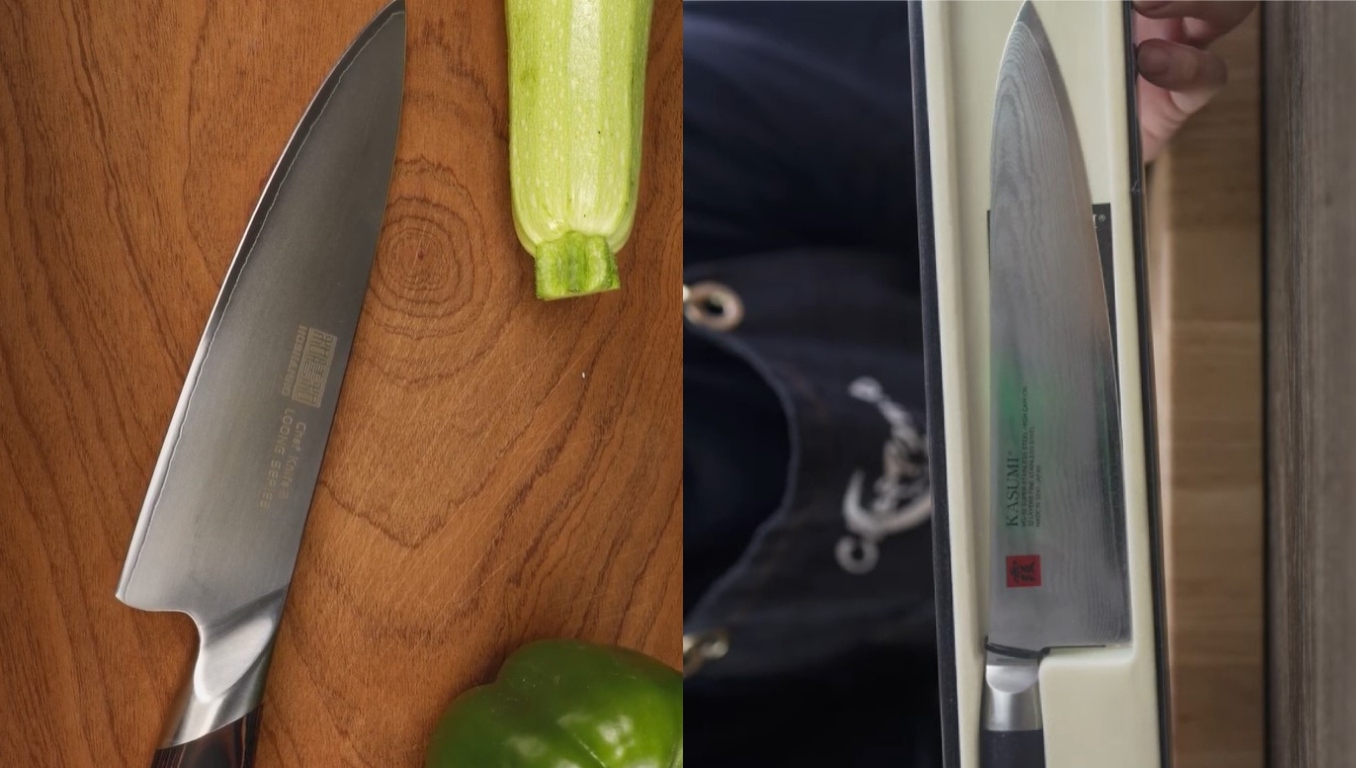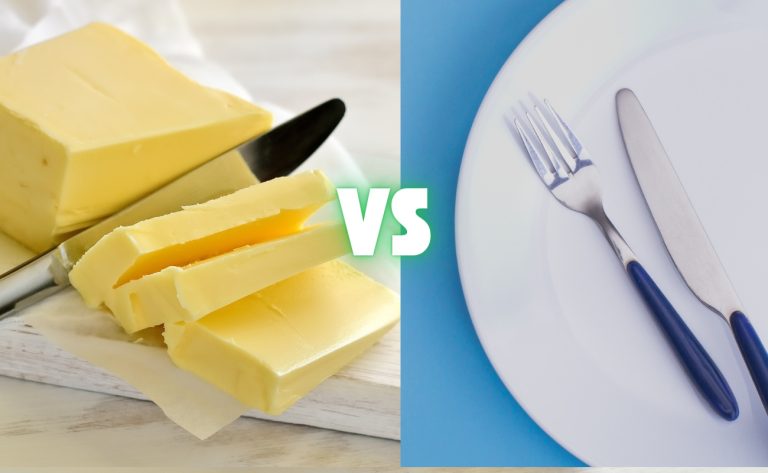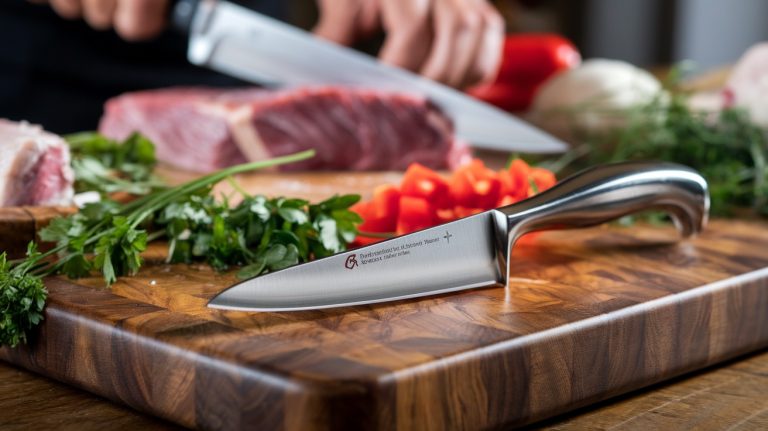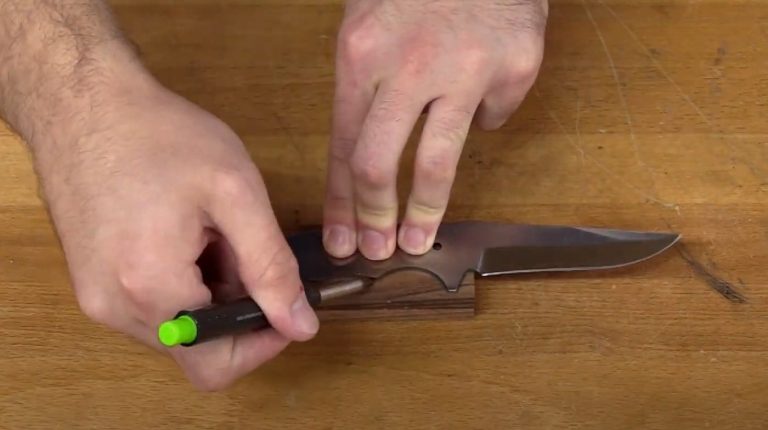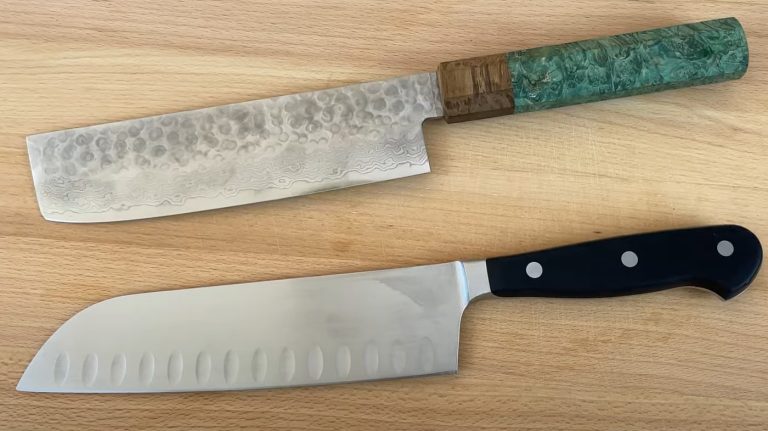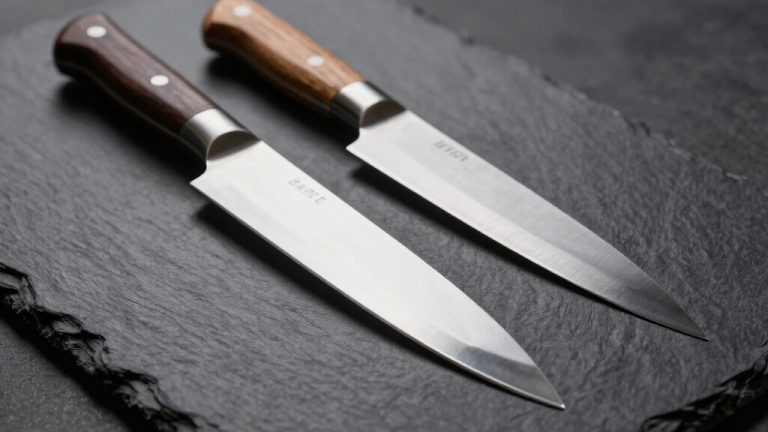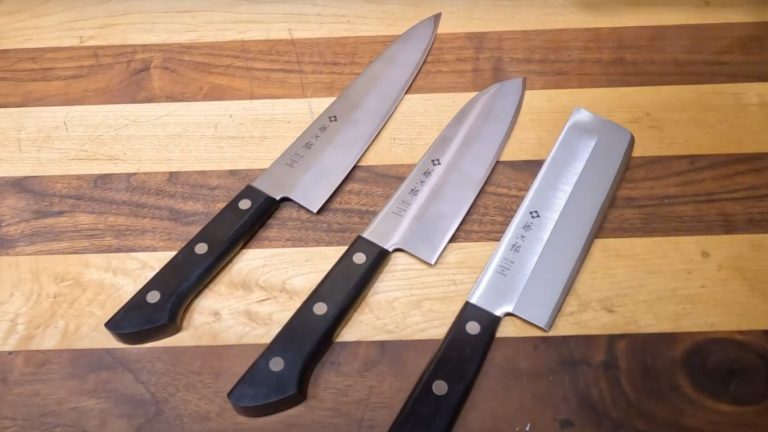AUS 10 vs VG 10: Knife Steel Showdown
When deciding between AUS-10 and VG-10, you’re looking at two high-performing Japanese steels with distinct strengths.
AUS-10 offers 0.95-1.10% carbon and solid toughness, making it ideal for heavy outdoor tasks with a hardness of 58-62 HRC.
VG-10, with higher carbon and 15% chromium, excels in edge retention and corrosion resistance, perfect for precise kitchen slicing at 60 HRC. Stick around to uncover deeper insights into their unique applications and performance.
Key Takeaways
- AUS-10 offers better toughness for heavy tasks, while VG-10 excels in edge retention for precise slicing.
- VG-10 has superior corrosion resistance due to higher chromium content compared to AUS-10.
- AUS-10 is more affordable and easier to sharpen than VG-10.
- VG-10 suits delicate kitchen tasks; AUS-10 is ideal for outdoor and heavy use.
- Hardness is similar, but VG-10 often reaches slightly higher HRC for better wear resistance.
Composition Breakdown of AUS-10 and VG-10
While both AUS-10 and VG-10 are renowned for their performance in high-end knives, let’s explore their chemical compositions to understand what sets them apart.
You’ll notice AUS-10 contains 0.95-1.10% carbon, ensuring sharp edges and wear resistance, while VG-10’s high carbon content similarly boosts edge retention.
Check their chromium levels—AUS-10 has 13.0-14.5%, forming a rust-resistant oxide layer, but VG-10’s chromium offers superior corrosion protection.
You’ll find AUS-10 includes 0.10-0.25% vanadium for grain refinement and 0.10-0.30% molybdenum for added strength.
VG-10 also has vanadium and likely molybdenum, enhancing carbide formation. Additionally, the presence of vanadium in both steels contributes significantly to their overall toughness and edge retention capabilities.
Analyze these balances; they’re critical for performance. Both steels share high-carbon stainless traits, but VG-10’s corrosion edge and subtle elemental tweaks distinguish it in precise applications.
Hardness and Durability Compared
As you examine the hardness levels of AUS-10 and VG-10, you’ll notice both steels achieve impressive ranges, with AUS-10 spanning 58-62 HRC and VG-10 around 60 HRC, directly impacting their sharpness and wear resistance.
These hardness values are crucial for maintaining edge retention, a key factor in carbon steel knives and stainless steel knives performance.
When evaluating durability under stress, you’ll find that their high hardness contributes to longevity, though subtle differences in composition affect how each handles prolonged use.
Additionally, the specific alloying elements like vanadium and molybdenum in both steels enhance their overall strength and resistance to wear like vanadium enhances.
Turning to impact resistance, you’ll see AUS-10’s slight edge in toughness, making it more resilient to accidental drops or bending compared to VG-10.
Hardness Levels Explained
Immerse yourself in the critical aspect of hardness levels with AUS-10 and VG-10, two premium steels often compared for their performance in high-end applications.
You’ll find AUS-10 typically ranges from 58-62 HRC on the Rockwell scale, while VG-10 often matches this range, though heat treatment can push it slightly higher. This hardness guarantees both steels excel in edge retention, with VG-10 having a marginal advantage due to its higher carbide content.
Notice how alloy elements like chromium, carbon, and vanadium bolster their high hardness, while their microstructure influences performance. Additionally, AUS-10 is known for its durability, making it a reliable choice for demanding tasks AUS-10 durability.
Despite this, you’ll appreciate that both remain relatively easy to sharpen. Understand that hardness directly impacts cutting ability and edge maintenance, making these steels ideal for precision tasks.
Durability Under Stress
Explore the durability of AUS-10 and VG-10 under stress, a key factor in determining their suitability for demanding tasks. You’ll find AUS-10 excels with higher toughness and robust tensile strength, making it less prone to breaking under pressure.
VG-10, while slightly harder at 58-60 HRc or above, doesn’t match AUS-10’s resilience to stress despite its fine carbide structure. Additionally, AUS-10 benefits from vanadium content, which enhances grain refinement benefits.
Check this comparison for a clearer picture:
| Steel Type | Toughness Rating | Stress Durability |
|---|---|---|
| AUS-10 | High | Excellent |
| VG-10 | Moderate | Good |
Impact Resistance Analysis
Precision matters when evaluating the impact resistance of AUS-10 and VG-10, two high-performing steels often compared for their hardness and durability.
When you assess them, note that VG-10 boasts a higher Rockwell hardness of 60-62 HRC compared to AUS-10’s 58-60 HRC, indicating better deformation resistance.
However, AUS-10’s vanadium content refines its grain structure, enhancing wear resistance and toughness under impact.
You’ll find VG-10 excels in edge retention due to its cobalt addition, while AUS-10 offers comparable toughness for rough use.
Impact tests reveal VG-10 withstands more force without deforming, but AUS-10 remains a strong contender.
Additionally, AUS-10’s high chromium content ensures excellent corrosion resistance, making it suitable for harsh environments high chromium content.
Edge Retention and Sharpness Analysis
Engage with the critical aspect of edge retention and sharpness when comparing AUS-10 and VG-10 steels, as these factors directly impact a knife’s performance.
You’ll notice both steels offer similar edge retention due to high hardness and carbide structures, with VG-10 having a slight edge in carbide volume. This means VG-10 might hold sharpness a tad longer, though in practical use, you’ll barely discern a difference.
It’s important to consider that edge retention often trades off with toughness, so balancing these properties is key when selecting a steel for your knife.
Analyze their properties with this detailed comparison:
| Aspect | AUS-10 | VG-10 |
|---|---|---|
| Hardness Level | High, balanced with toughness | High, slightly less tough |
| Carbide Volume | Moderate, supports retention | Slightly higher, better edge |
| Vanadium Content | Enhances grain refinement | Boosts edge retention |
| Practical Performance | Excellent for various uses | Comparable, minimal difference |
Corrosion Resistance in Different Environments
While edge retention often steals the spotlight, don’t overlook corrosion resistance when comparing AUS-10 and VG-10 steels in varied environments.
You’ll notice VG-10’s 15% chromium content offers a marginal edge over AUS-10’s 13.5-14.5% in forming a protective passive layer, especially in humid conditions. VG-10’s extra chromium and frequent cladding provide slightly better long-term protection against oxidation.
VG-10’s 15% chromium slightly outperforms AUS-10’s 13.5-14.5%, ensuring better oxidation protection in humid environments with its enhanced passive layer.
In practical settings like home kitchens, however, you won’t see significant differences. Both steels resist mild acidic foods like citrus equally, though VG-10’s higher carbon content poses a minor pitting risk. Additionally, VG-10’s molybdenum content enhances its ability to prevent pitting corrosion in challenging environments.
You must rinse both after saltwater exposure and avoid dishwashers—harsh detergents degrade their passive layers. Maintain them identically: dry immediately, use pH-neutral soap, and apply mineral oil for storage.
Toughness for Various Applications
When evaluating toughness for various applications, you’ll notice that AUS-10 offers superior kitchen cutting durability with its enhanced impact resistance, making it reliable for heavy chopping tasks.
For outdoor task resilience, you can count on AUS-10’s better bending resistance, which handles rugged conditions without deforming, while VG-10’s rigidity might limit its performance in extreme scenarios.
Additionally, it’s important to recognize that a balance between hardness and toughness is essential for optimal performance in diverse conditions.
Comparing impact resistance, you’ll find AUS-10 absorbs shock more effectively, reducing risks of chipping compared to the somewhat brittler VG-10.
Kitchen Cutting Durability
As you evaluate kitchen knives for durability, toughness under various cutting applications becomes a critical factor in distinguishing AUS10 from VG10 steels.
You’ll notice AUS10’s leaner alloy reduces brittleness, making it ideal for chopping dense vegetables or breaking down poultry with better lateral stress absorption. VG10, while excelling in controlled slicing, risks chipping on frozen foods or bones if you’re not precise.
Check this comparison for clarity:
| Steel Type | Chopping Durability | Chip Resistance |
|---|---|---|
| AUS10 | High (dense materials) | Superior (lateral stress) |
| VG10 | Moderate (precision focus) | Lower (risk on hard items) |
Outdoor Task Resilience
Shifting focus from kitchen cutting durability, let’s examine how AUS10 and VG10 steels perform in outdoor task resilience under demanding conditions.
When you’re tackling rugged outdoor tasks, you need a blade that withstands stress and harsh environments. AUS10, with its finer grain structure and vanadium content, often outshines VG10 in toughness, making it a reliable choice for extreme conditions.
Both offer solid corrosion resistance, though VG10’s higher chromium and molybdenum levels give it a slight edge in moist settings. Additionally, AUS10’s balanced hardness of 58-60 HRC ensures durability under stress during prolonged outdoor use.
Consider these key aspects:
- Toughness: AUS10’s composition handles demanding outdoor tasks better.
- Edge Retention: Both maintain sharpness, but AUS10 excels in harsh use.
- Corrosion: VG10 resists moisture slightly more effectively.
Impact Resistance Comparison
Plunge into the critical aspect of impact resistance, where toughness defines a blade’s ability to endure stress without chipping or cracking.
When you’re choosing between AUS-10 and VG-10, note that AUS-10 likely offers slightly better toughness, thanks to its nickel content enhancing ductility. This makes it more suitable for high-impact tasks where absorbing energy is essential.
On the other hand, VG-10, with its focus on edge retention and cobalt-enhanced hardness, may chip under heavy stress, limiting its use in demanding applications.
Ease of Sharpening and Maintenance
Many knife enthusiasts find that both AUS-10 and VG-10 steels offer distinct experiences when it comes to ease of sharpening and maintenance.
When you’re sharpening, AUS-10 proves more user-friendly, adapting well to various tools like whetstones or ceramic rods. VG-10, with its higher hardness, demands precision but still sharpens effectively if you maintain consistent angles.
For maintenance, you’ll need to clean and dry both steels regularly to prevent corrosion, especially VG-10, which is more prone to pit corrosion.
Here’s what you should focus on:
- *Sharpen consistently*: Keep angles steady to preserve blade geometry.
- *Hone regularly*: Maintain sharpness between full sharpenings.
- *Oil periodically*: Protect surfaces with a light coat of knife oil.
Manufacturing Challenges and Costs
As we explore the manufacturing challenges and costs of AUS-10 and VG-10, you’ll notice that both steels, while high-performing, present distinct hurdles in production.
You’re dealing with precise heat treatment demands and strict quality control to maintain consistent chemical composition and hardness—often 60-61 HRC for VG-10.
AUS-10, produced by Aichi Steel, is more accessible and affordable, whereas VG-10, from Takefu Special Steel, often costs more due to complex carbide content and lower production volumes.
Additionally, AUS-10 benefits from a balanced composition that enhances durability, making it a practical choice for manufacturers aiming for cost-effective yet reliable performance.
Here’s a concise comparison:
| Aspect | AUS-10 | VG-10 |
|---|---|---|
| Production Cost | Generally lower | Higher due to complexity |
| Heat Treatment Challenge | High precision needed | Equally demanding |
| Market Availability | More accessible | Limited by volume |
Ideal Uses in Kitchen and Outdoor Settings
As you evaluate VG10 and AUS10 for kitchen cutting precision, notice how VG10’s superior edge retention and sharpening ease make it ideal for delicate slicing tasks like sushi preparation.
When you shift focus to outdoor rugged durability, you’ll find AUS10’s enhanced toughness and chip resistance better suited for demanding tasks such as batoning or processing tough materials.
For versatile blade applications, consider how each steel balances performance across both settings, with VG10 excelling in precision and AUS10 dominating in durability under varied loads.
Kitchen Cutting Precision
Immerse yourself in the domain of kitchen cutting precision, where the choice between VG-10 and AUS-10 steels can greatly influence your performance.
You’ll notice VG-10, with its 60-62 HRC hardness and superior edge retention, excels in tasks like slicing and dicing, keeping your cuts razor-sharp longer. Its fine grain structure enhances edge-holding ability for precision tasks.
Meanwhile, AUS-10, at 56-58 HRC, offers slightly better toughness, making it reliable for heavy-use kitchen tasks without chipping.
Additionally, VG-10’s composition, enriched with elements like chromium and molybdenum, provides superior corrosion resistance compared to many other steels, ensuring longevity in humid kitchen environments.
Consider these key differences when choosing:
- VG-10: Opt for this if you prioritize precision cutting and don’t mind occasional maintenance.
- AUS-10: Select this for durability in demanding, repetitive tasks.
- Balanced Needs: Weigh edge retention against toughness based on your cutting style.
Outdoor Rugged Durability
Dive straight into the domain of outdoor rugged durability, where the choice between AUS-10 and VG-10 steels can make or break your performance in harsh conditions.
If you’re tackling demanding outdoor tasks, AUS-10’s superior toughness and impact resistance, bolstered by vanadium for finer grain structure, guarantee it withstands bending and rough use. You’ll appreciate its lower maintenance needs in brutal environments.
Conversely, if you’re in damp or marine settings, VG-10’s higher chromium and molybdenum content offers better corrosion resistance, protecting against rust.
However, you’ve gotta maintain it diligently due to its higher carbon content, as neglect can invite minor corrosion.
Versatile Blade Applications
Precision matters when exploring the versatile blade applications of AUS-10 and VG-10 steels in kitchen and outdoor settings.
You’ll find both excel in controlled culinary tasks, with VG-10’s edge retention and stain resistance slightly better for sushi slicing. However, AUS-10’s toughness shines in outdoor scenarios, handling batoning and game prep without deformation.
Consider these key uses for your blade selection:
- Kitchen Precision: Opt for VG-10 if you’re cutting acidic foods daily; its chromium content resists stains better.
- Outdoor Durability: Choose AUS-10 for camp tasks; it withstands impact and field sharpening with ease.
- Hybrid Scenarios: Rely on AUS-10 for mixed kitchen-field roles; it balances corrosion resistance and resilience.
Performance Against Other Popular Steels
Take a close look at how VG10 and AUS10 stack up against each other and other popular steels in critical performance metrics.
You’ll notice VG10’s edge retention shines with higher vanadium content, rivaling premium 154CM, though it risks microchipping under stress.
AUS10, with better toughness, outperforms 440C in impact resistance, handling lateral forces well.
When it comes to corrosion resistance, VG10’s 15% chromium content beats AUS10’s 13–14.5%, excelling against acidic degradation.
For sharpening, AUS10 responds quicker with lower carbide volume, while VG10 demands precision for a keener edge.
Heat treatment’s trickier with VG10, requiring strict control to avoid brittleness, whereas AUS10 forgives minor errors, maintaining consistent hardness.
Frequently Asked Questions
Which Steel Is Better for Beginners?
Imagine you’re a novice chef, nervously slicing through tough veggies for your first family dinner, and your knife chips—heartbreaking, right?
When choosing steel for beginners, prioritize toughness over finesse. Opt for a blade with higher impact resistance to forgive early mistakes.
Consider cost and ease of sharpening too. With a hardness around 58–62 HRC, you’ll maintain it easily using medium-grit stones.
Build confidence without fearing damage during your learning curve.
How Do They Handle Extreme Temperatures?
When you’re dealing with extreme temperatures, you’ve gotta know how materials perform under stress.
You’ll find that high carbon and chromium content guarantee stability, resisting corrosion even in harsh heat or freezing cold. Expect minimal thermal expansion, though heat might increase microchipping risks—counter this with regular maintenance.
In cold, toughness prevents cracking, while corrosion resistance holds up in moist conditions. Keep your gear clean and dry to maintain performance.
Are There Specific Sharpening Angles Recommended?
Hey, when it comes to sharpening angles, you’ve gotta aim for precision.
Stick to a range of 15° to 20° per side for most blades, depending on how sharp you need that edge and the cutting task. Adjust the bevel angle slightly to optimize sharpness and retention.
Keep your angles consistent with each pass, and don’t skip regular honing to maintain that edge’s performance over time.
Which Steel Is More Eco-Friendly?
Did you know that stainless steel production emits about 2.5 tons of CO2 per ton produced?
When evaluating eco-friendliness in steel choices, you’ll find durability and recyclability are key factors.
Opt for steels with longer lifespans to reduce waste.
Analyze their production processes—higher resource efficiency matters.
You’re also wise to contemplate recyclable content.
Ultimately, pick materials that balance sustainability with performance, ensuring you minimize environmental impact through informed decisions.
How Do They Perform in Saltwater?
You’re evaluating how certain steels perform in saltwater environments.
You’ll find that high chromium content boosts corrosion resistance, but prolonged exposure can still cause issues. Surface rust might develop if you don’t clean regularly.
For occasional use, you’re fine, but continuous saltwater contact demands extra care. Apply rust inhibitors and rinse after exposure.
Compared to specialized options, these steels aren’t the best for extreme conditions without diligent maintenance.
Hardness, Sharpness, Durability—Make the Informed Pick
You’ve analyzed AUS-10 and VG-10, so now decide with precision. Choose AUS-10 for its balanced toughness, resist wear with confidence, and wield it in diverse tasks.
Opt for VG-10 for superior sharpness, retain that edge with certainty, and master intricate cuts. Weigh their hardness, assess their corrosion resistance, and evaluate their cost.
Make your pick based on data—let performance drive your choice in kitchen or outdoor challenges ahead.

